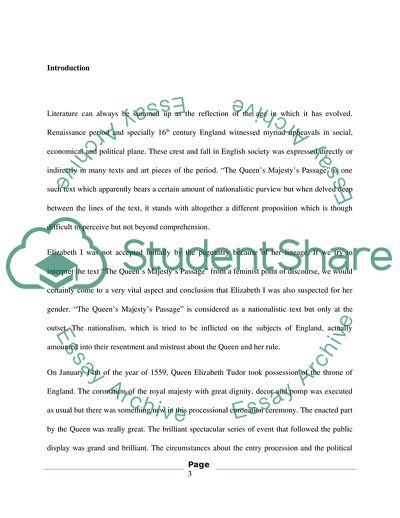Cite this document
(English Renaissance, Queen Elizabeth Tudor Politics Research Paper, n.d.)
English Renaissance, Queen Elizabeth Tudor Politics Research Paper. Retrieved from https://studentshare.org/history/1736213-english-renaissance-the-queens-majestys-passage-is-portrayed-as-a-nationalistic-text-but-in-actuality-indicates-englands-doubt-in-elizabeth-during-her-initial-pageantry-into-the-monarchy-due-to-her-controversial-lineage-and-gender
English Renaissance, Queen Elizabeth Tudor Politics Research Paper. Retrieved from https://studentshare.org/history/1736213-english-renaissance-the-queens-majestys-passage-is-portrayed-as-a-nationalistic-text-but-in-actuality-indicates-englands-doubt-in-elizabeth-during-her-initial-pageantry-into-the-monarchy-due-to-her-controversial-lineage-and-gender
(English Renaissance, Queen Elizabeth Tudor Politics Research Paper)
English Renaissance, Queen Elizabeth Tudor Politics Research Paper. https://studentshare.org/history/1736213-english-renaissance-the-queens-majestys-passage-is-portrayed-as-a-nationalistic-text-but-in-actuality-indicates-englands-doubt-in-elizabeth-during-her-initial-pageantry-into-the-monarchy-due-to-her-controversial-lineage-and-gender.
English Renaissance, Queen Elizabeth Tudor Politics Research Paper. https://studentshare.org/history/1736213-english-renaissance-the-queens-majestys-passage-is-portrayed-as-a-nationalistic-text-but-in-actuality-indicates-englands-doubt-in-elizabeth-during-her-initial-pageantry-into-the-monarchy-due-to-her-controversial-lineage-and-gender.
“English Renaissance, Queen Elizabeth Tudor Politics Research Paper”, n.d. https://studentshare.org/history/1736213-english-renaissance-the-queens-majestys-passage-is-portrayed-as-a-nationalistic-text-but-in-actuality-indicates-englands-doubt-in-elizabeth-during-her-initial-pageantry-into-the-monarchy-due-to-her-controversial-lineage-and-gender.


